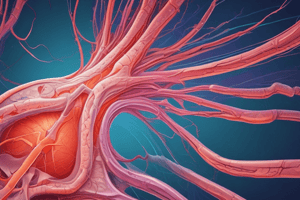Podcast
Questions and Answers
What is the primary function of elastin fibres in connective tissue?
What is the primary function of elastin fibres in connective tissue?
- To enable elasticity and relaxation in tissues (correct)
- To facilitate the diffusion of oxygen and nutrients
- To provide structural support to organs
- To form the framework of soft organs
What type of connective tissue is characterized by a viscous consistency and allows for the diffusion of oxygen and nutrients?
What type of connective tissue is characterized by a viscous consistency and allows for the diffusion of oxygen and nutrients?
- Specialised connective tissue
- Mineralized connective tissue
- Dense connective tissue
- Clean connective tissue (correct)
Which type of cell is found in cartilaginous tissue?
Which type of cell is found in cartilaginous tissue?
- Fibroblasts
- Adipocytes
- Chondrocytes (correct)
- Osteocytes
What is the main difference between irregular dense connective tissue and regular dense connective tissue?
What is the main difference between irregular dense connective tissue and regular dense connective tissue?
What is the function of reticulin fibres in connective tissue?
What is the function of reticulin fibres in connective tissue?
What is the characteristic of the matrix in cartilaginous tissue?
What is the characteristic of the matrix in cartilaginous tissue?
Which type of connective tissue is characterized by a predominance of fibres and great resistance?
Which type of connective tissue is characterized by a predominance of fibres and great resistance?
What is the function of the fundamental substance in connective tissue?
What is the function of the fundamental substance in connective tissue?
Which type of connective tissue is found in the dermis, blood vessels, and surrounding the small intestine?
Which type of connective tissue is found in the dermis, blood vessels, and surrounding the small intestine?
What is the characteristic of the fibroblasts in dense connective tissue?
What is the characteristic of the fibroblasts in dense connective tissue?
Study Notes
Connective Tissue
- Combination of cells and extracellular matrix (ECM)
- ECM: fibres, water, and soluble molecules
- Functions: supports and unites cells, allows diffusion of O2 and nutrients
Cells of Connective Tissue
- Fixed cells: fibroblasts, myofibroblasts, pericytes, adipocytes, macrophages
- Mobile cells: derived from haematopoietic stem cells, migrate to connective tissue, short lifespan
Fibroblasts
- Present in all types of connective tissue
- Spindle-shaped, elongated cell with numerous extensions
- Synthesise most of the ECM components
- Exist in two forms: fibroblasts (active) and fibrocytes (resting, inactive)
Myofibroblasts
- Morphology intermediate between muscle cells and fibroblasts
- Presence of actin filaments and myosin (contractile function)
- Important role in healing process and tissue repair
Pericytes
- Surround blood capillaries and venules
Adipocytes
- Specialised in lipid storage and hormone production
- Derived from adipoblasts
Classification of Connective Tissue
- Loose connective tissue: balanced, dense
- Mineralized connective tissue: cartilage, bone
- Specialised connective tissue: adipose, blood
Loose Connective Tissue
- Cells, fibres, and matrix in the same proportion
- Matrix has viscous consistency, allows diffusion of O2 and nutrients
- Provides elasticity and support, located under covering epithelium, associated with glands and surrounds blood vessels
Dense Connective Tissue
- Fibres predominate, providing great resistance
- Fibroblasts rare, fundamental substance not very abundant
- Two types: irregular dense tissue, regular dense tissue
Studying That Suits You
Use AI to generate personalized quizzes and flashcards to suit your learning preferences.
Description
Understand the structure and functions of connective tissue, including the types of cells present and their roles in the human body.




